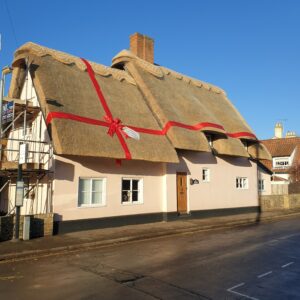If you’re wondering whether you should get a thatched roof, then you’ve come to the right place. We are here to inform you on the advantages and the disadvantages of thatched roofs, as well as the different types you can get.
What is a thatched roof?
A thatched roof is the oldest type of roof that is still being built today, as it has a history of over 10,000 years. To construct a thatched roof, straw or water reed is laid in a way to protect the inner roof from moisture from the weather. By densely packing your thatching materials, you can also trap a layer or air to insulate your building.
In this article, we will give you all the information you need to know so you can make the decision on whether to buy a property that already has a thatched roof or have one built on an existing house. If you want to know how much it costs to thatch a roof or how long the thatch roof will last, then we can help you with that.
Advantages of a thatched roof
Besides being appealing to look at, having a thatched roof on your property comes with numerous advantages.
- Increased home value – having a thatched roof on your property increases the value of your home. While a thatched roof can be a pricey investment, it’s often a good investment. Numerous homes across the UK have found that their value has increased due to having a well maintained thatched roof.
- Can fit any building shape – Due to the flexible nature of thatching materials, it can be shaped to fit any roof. This leads to some interesting roof designs that can be fully customised.
- Durability – Contrary to popular opinion, thatched roofs are incredibly long-lasting, as long as they have been constructed by a reputable thatching company. With the correct maintenance, a water reed thatched roof can last from 25 to 40+ years, and a straw thatch roof can last from 15 to 25 years.
- Eco-friendly – Roof thatching materials are grown from the ground, making it a renewable resource. Thatched roofs are totally sustainable when compared to slate roofs.
- Great insulation – By densely packing your thatch, you can trap a layer of air to insulate your building. This will keep it cool in the summer and warm in the winter.
Disadvantages of thatched roofs
There are definitely some downside to having a thatched roof, how
- Intensive process – Getting your roof fully thatched is an intensive process, both with cost and time. After you get a quote, the planning can take weeks, with larger properties taking more time and costing more money.
- Maintenance costs – In order to keep your roof in the best possible condition, you will have to get it regularly checked by professionals. Expert thatchers will know to check for leaks, moss, nesting, and decay from the weather. We can give you advice to help you keep your roof in the best condition for as long as possible, but this will cost you both time, money and effort. However, the results are well worth the expenditure.
- Thatch fires – While uncommon, it is important that your roof is checked regularly to minimise the risk of a fire. While the risk is about the same as a typical slate roof, it’s important to minimise the risk nonetheless. We will check your insulation as well as your chimney to ensure that the risk is 0.
If you are still wondering whether you should get a thatched roof, feel free to contact one of our experts. We know all there is to know about roof thatching, so we can help you with a bespoke roof for your property. All in all, make sure you choose a reputable thatching company before you decide to get a thatched roof.


